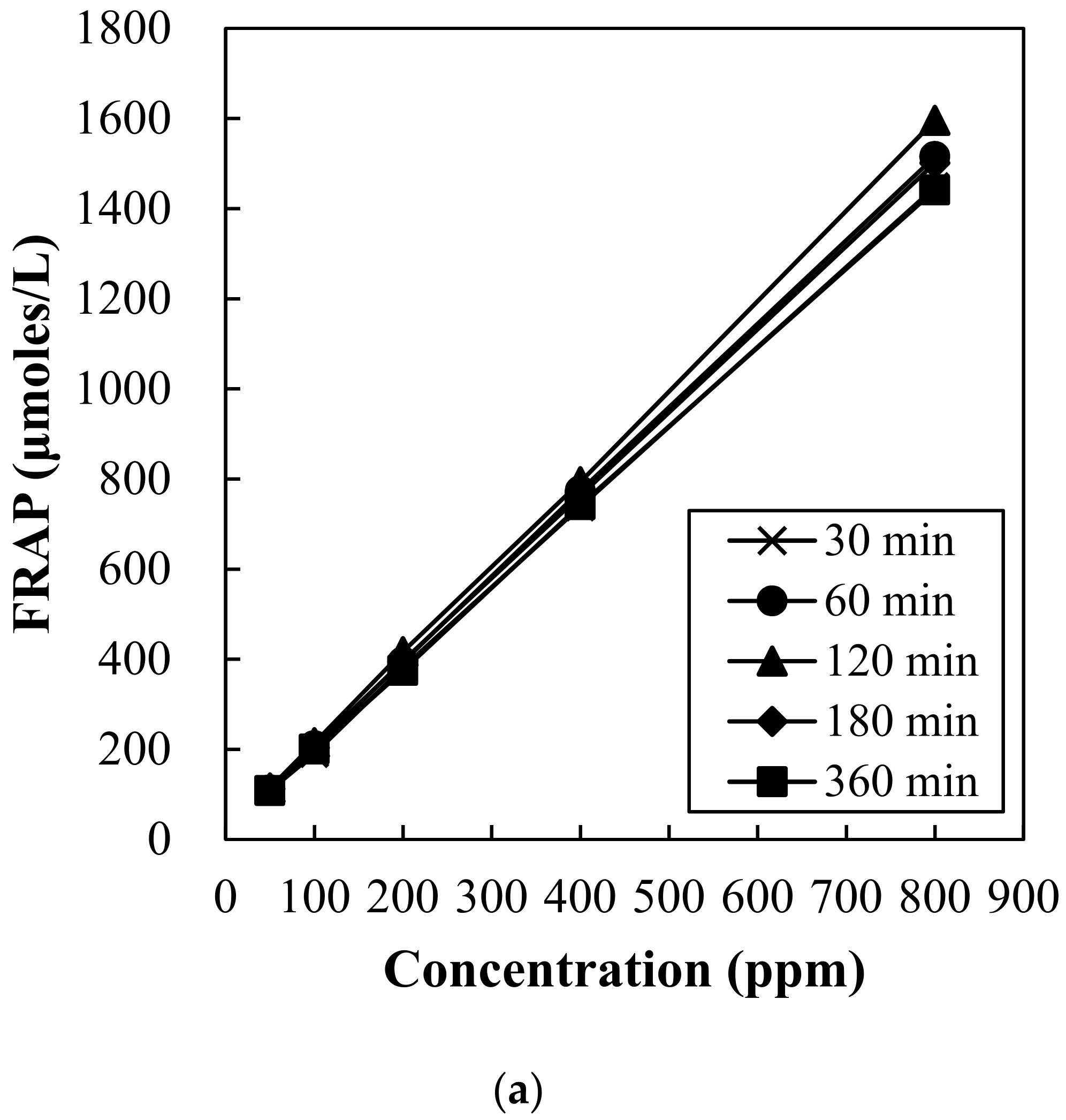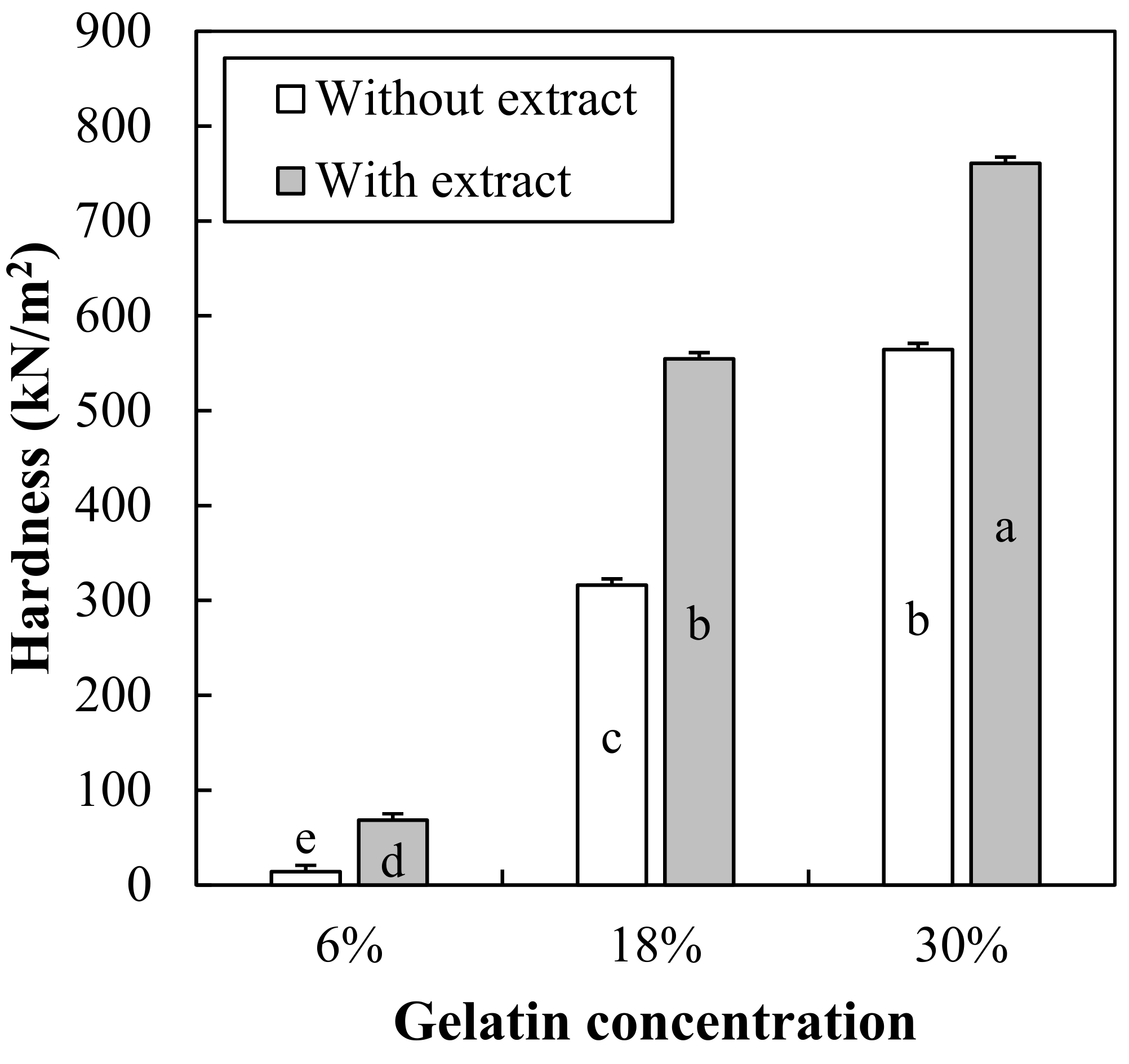Quality Characteristics of Senior-Friendly Gelatin Gels Formulated with Hot Water Extract from Red Maple Leaf as a Novel Anthocyanin Source
Abstract
1. Introduction
2. Materials and Methods
2.1. Experimental Design and Arrangement
2.2. Hot Water Extraction of Red Maple Leaf (Experiment I)
2.3. Analysis of Antioxidant Capacity of Red Maple Leaf Extract
2.3.1. Total Phenol Content
2.3.2. Anthocyanin Content
2.3.3. DPPH Radical Scavenging Activity
2.3.4. Ferric Reducing Antioxidant Power
2.4. Manufacture of Gelatin Gels with Red Maple Leaf Extract (Experiment II)
2.5. Physicochemical Analysis of Gelatin Gels with Red Maple Leaf Extract
2.5.1. Surface Color Measurement
2.5.2. Free Anthocyanin Content
2.5.3. Hardness
2.6. Statistical Analysis
3. Results and Discussion
3.1. Total Phenol and Anthocyanin Contents of Hot Water Extract from Red Maple Leaf
3.2. Antioxidant Capacity of Hot Water Extract from Red Maple Leaf
3.3. Color Characteristics of Gelatin Gels with Red Maple Leaf Extract
3.4. Free Anthocyanin Content of Gelatin Gels with Red Maple Leaf Extract
3.5. Hardness of Gelatin Gels with Red Maple Leaf Extract
4. Conclusions
Author Contributions
Funding
Institutional Review Board Statement
Informed Consent Statement
Acknowledgments
Conflicts of Interest
References
- Andriollo, S.M.; Hininger, F.I.; Meunier, N.; Venneria, E.; O’Connor, J.M.; Maiani, G.; Coudray, C.; Roussel, A.M. Age-related oxidative stress and antioxidant parameters in middle-aged and older European subject: The ZENITH study. Eur. J. Clin. Nut. 2005, 59, 58–62. [Google Scholar] [CrossRef]
- Touyz, R.M. Reactive oxygen species in vascular biology: Role in arterial hypertension. Expert Rev. Cardiovasc. Therl. 2003, 1, 91–106. [Google Scholar] [CrossRef]
- Finkel, T.; Holbrook, N.J. Oxidants, oxidative stress and the biology of ageing. Nature 2002, 408, 239–247. [Google Scholar] [CrossRef]
- Lee, K.P.; Eun, H.G.; Lim, I.S. Potentially harmful effects and effect of antioxidant by oxygen free radical during maximal exercise. Korean J. Phys. Educ. 1997, 36, 243–255. [Google Scholar]
- Kim, B.M.; Lee, K.M.; Jung, I.C. Changes in anthocyanin content of aronia (Aronia melancocarpa) by processing conditions. Korea J. Plant Res. 2017, 30, 152–159. [Google Scholar] [CrossRef][Green Version]
- Kim, N.S.; Shon, M.S.; Kim, G.N.; Hwang, Y.I. Anti-obese and antioxidant activities of spica prunellae extract in 3T3-L1 and HepG2 cells. Food Eng. Prog. 2014, 18, 413–418. [Google Scholar] [CrossRef]
- Yashin, A.; Yashin, Y.; Xia, X.; Nemzer, B. Antioxidant activity of spices and their impact on human health: A review. Antioxidants 2017, 6, 70. [Google Scholar] [CrossRef] [PubMed]
- Wojtunik-Kulesza, K.; Oniszczuk, A.; Oniszczuk, T.; Combrzyński, M.; Nowakowska, D.; Matwijczuk, A. Influence of in vitro digestion on composition bioaccessibility and antioxidant activity of food polyphenols-A non-systematic review. Nutrients 2020, 12, 1401. [Google Scholar] [CrossRef] [PubMed]
- Kang, S.A.; Lee, S.H.; Shim, Y.N.; Oh, M.J.; Lee, N.R.; Park, S.M. Antioxidant capacity of anthocyanin-rich fruits and vegetables and changes of quality characteristics of black carrot added pudding according to storage. J. Appl. Biol. Chem. 2016, 59, 273–280. [Google Scholar] [CrossRef]
- Kim, Y.H.; Kim, D.S.; Woo, S.S.; Kim, H.H.; Lee, Y.S.; Kim, H.S.; Ko, K.O.; Lee, S.K. Antioxidant activity and cytotoxicity on human cancer cells of anthocyanin extracted from black soy bean. Korean J. Crop. Sci. 2008, 53, 407–412. [Google Scholar]
- Jang, H.H.; Nam, S.Y.; Jung, M.J.; Kim, J.B.; Kim, H.R.; Lee, Y.M. Antioxidant activity and protective effects of anthocyanins-rich fraction from Korean purple sweet potato variety, “Shinjami” against oxidative stress in HepG2 Cell. Korean J. Food Nutr. 2014, 27, 1090–1095. [Google Scholar] [CrossRef]
- Bi, W.; Gao, Y.; Shen, J.; He, C.; Liu, H.; Peng, Y.; Zhang, C.; Xiao, P. Traditional uses, phytochemistry, and pharmacology of the genus Acer (maple): A review. J. Ethnopharmacol. 2016, 189, 31–60. [Google Scholar] [CrossRef]
- Sung, Y.W.; Chang, M.J.; Choi, Y.K.; Song, H.; Shim, S.Y.; Yoon, J.Y.; Kim, K.J.; Kim, H.J. Seasonal variation of anti-oxidant and anti-bacterial activities in Acer palmatum extract. Asian J. Beauty Cosmetol. 2019, 17, 421–430. [Google Scholar] [CrossRef]
- Schaberg, P.G.; Murakami, P.F.; Butnor, J.R.; Hawley, G.J. Experimental branch cooling increases foliar sugar and anthocyanin concentrations in sugar maple at the end of the growing season. Can. J. For. Res. 2017, 47, 696–701. [Google Scholar] [CrossRef]
- Cheng, X.; Yang, Y.; Schwebel, D.C.; Liu, Z.; Li, L.; Cheng, P.; Ning, P.; Hu, G. Population ageing and mortality during 1990–2017: A global decomposition analysis. PLoS Med. 2020, 17, e1003138. [Google Scholar] [CrossRef] [PubMed]
- Choi, E.J.; Lee, J.E.; Oh, M.S. The quality characteristics of grape jelly made with various gelling agents for consumption by elderly women. Korean J. Food Cook. Sci. 2007, 23, 891–898. [Google Scholar]
- Lee, J.H.; Ji, Y.J. Quality and antioxidant properties of gelatin jelly incorporated with cranberry concentrate. J. Korean Soc. Food Sci. Nutr. 2015, 44, 1100–1103. [Google Scholar] [CrossRef]
- Lee, E.S.; Lee, Y.J.; Kim, J.H.; Chun, S.S. Quality characteristics of jelly with Lemon Myrtle (Backhousia citriodora) extracts. Korean J. Food Nutr. 2020, 33, 131–141. [Google Scholar]
- Lim, J.Y.; Kim, O.H.; Kim, J.H. Effects of antioxidant supplementation on lipid profiles in elderly women. Korean J. Community Nutr. 2006, 11, 133–142. [Google Scholar]
- Jun, H.I.; Jang, S.W.; Oh, H.H.; Jeong, D.Y.; Song, G.S. Antioxidant activity and anthocyanin analysis of blueberry with different extraction conditions. J. Korean Soc. Food Sci. Nutr. 2019, 48, 1223–1232. [Google Scholar] [CrossRef]
- Lin, J.Y.; Tang, C.Y. Determination of total phenolic and flavonoid contents in selected fruits and vegetables, as well as their stimulatory effects on mouse splenocyte proliferation. Food Chem. 2007, 101, 140–147. [Google Scholar] [CrossRef]
- Giusti, M.M.; Wrolstad, R.E. Characterization and measurement of anthocyanins by UV-visible spectroscopy. Curr. Protoc. Food Anal. Chem. 2001. [Google Scholar] [CrossRef]
- Sharma, O.P.; Bhat, T.K. DPPH antioxidant assay revisited. Food Chem. 2009, 113, 1202–1205. [Google Scholar] [CrossRef]
- Othman, A.; Ismail, A.; Ghani, N.A.; Adenan, I. Antioxidant capacity and phenolic content of cocoa beans. Food Chem. 2007, 100, 1523–1530. [Google Scholar] [CrossRef]
- Gu, T.W.; Song, D.H.; Noh, S.W.; Ham, Y.K.; Kim, H.W. Gel-forming and hardness of animal and plant protein gels at various concentrations for developing senior-friendly jelly foods. Korean J. Food Cook. Sci. 2020, 36, 305–312. [Google Scholar] [CrossRef]
- Choi, K.; Lee, J.; Jo, J.; Shin, S.; Kim, J.W. Optimization of hot-water extraction conditions of polyphenolic compounds from lipid extracted microalgae. Korean Chem. Eng. Res. 2016, 54, 310–314. [Google Scholar] [CrossRef][Green Version]
- Piljac-Žegarac, J.; Belščak, A.; Piljac, A. Antioxidant capacity and polyphenolic content of blueberry (Vaccinium corymbosum L.) leaf infusions. J. Med. Food. 2009, 12, 608–614. [Google Scholar] [CrossRef]
- Schmitzer, V.; Osterc, G.; Veberic, R.; Stampar, F. Correlation between chromaticity values and major anthocyanins in seven Acer palmatum Thunb. cultivars. Sci. Hortic. 2009, 119, 442–446. [Google Scholar] [CrossRef]
- Cirillo, G.; Curcio, M.; Vittorio, O.; Iemma, F.; Restuccia, D.; Spizzirri, U.G.; Puoci, F.; Picci, N. Polyphenol conjugates and human health: A perspective review. Crit. Rev. Food Sci. Nutr. 2014, 56, 326–337. [Google Scholar] [CrossRef]
- Roy, S.; Rhim, J.W. Anthocyanin food colorant and its application in pH-responsive color change indicator films. Crit. Rev. Food Sci. Nutr. 2021, 61, 2297–2325. [Google Scholar] [CrossRef]
- Silva, S.; Costa, E.M.; Calhau, C.; Morais, R.M.; Pintado, M.E. Anthocyanin extraction from plant tissues: A review. Crit. Rev. Food Sci. Nutr. 2017, 57, 3072–3083. [Google Scholar] [CrossRef]
- Wang, W.D.; Xu, S.Y. Degradation kinetics of anthocyanins in blackberry juice and concentrate. J. Food Eng. 2007, 82, 271–275. [Google Scholar] [CrossRef]
- Chung, C.; Rojanasasithara, T.; Mutilangi, W.; McClements, D.J. Stability improvement of natural food colors: Impact of amino acid and peptide addition on anthocyanin stability in model beverages. Food Chem. 2017, 218, 277–284. [Google Scholar] [CrossRef] [PubMed]
- Betz, M.; Kulozik, U. Whey protein gels for the entrapment of bioactive anthocyanins from bilberry extract. Int. Dairy J. 2011, 21, 703–710. [Google Scholar] [CrossRef]
- Tongmai, J.; Chupeeruch, C.; Suttisansanee, U.; Chamchan, R.; Khemthong, C.; On-nom, N. Development of anthocyanin-rich jelly by Thai mulberry (Morus alba) fruit powder. Walailak Procedia 2019, 2019, IC4IR-68. [Google Scholar]
- Hwang, E.S.; Thi, N.D. Quality characteristics of jelly containing aronia (Aronia melanocarpa) juice. Korea J. Food Sci. Technol. 2015, 47, 738–743. [Google Scholar] [CrossRef][Green Version]
- MFDS. Food Code. Chapter 8. General Analytical Method. 2021. Available online: https://foodsafetykorea.go.kr/foodcode/01_03.jsp?idx=272 (accessed on 3 November 2021).








| Traits | 6% Gelatin Gel | 18% Gelatin Gel | 30% Gelatin Gels | SEM (1) | Significance of p Value | |||||
|---|---|---|---|---|---|---|---|---|---|---|
| without Extract | with Extract | without Extract | with Extract | without Extract | with Extract | G (2) | E | G × E | ||
| L* | 57.70 a | 44.37 d | 55.37 b | 40.49 e | 49.39 c | 38.73 e | 1.243 | *** (3) | *** | * |
| (lightness) | ||||||||||
| a* | 0.17 e | 10.40 c | 0.34 de | 11.41 b | 0.42 d | 12.09 a | 0.933 | *** | *** | *** |
| (redness) | ||||||||||
| b* | 4.84 e | 25.23 b | 14.82 d | 26.73 a | 22.42 c | 26.68 a | 1.350 | *** | *** | *** |
| (yellowness) | ||||||||||
| Hue angle | 87.93 b | 67.60 c | 88.67 ab | 66.88 c | 88.92 a | 65.60 d | 1.849 | NS | *** | *** |
Publisher’s Note: MDPI stays neutral with regard to jurisdictional claims in published maps and institutional affiliations. |
© 2021 by the authors. Licensee MDPI, Basel, Switzerland. This article is an open access article distributed under the terms and conditions of the Creative Commons Attribution (CC BY) license (https://creativecommons.org/licenses/by/4.0/).
Share and Cite
Song, D.-H.; Gu, T.-W.; Kim, H.-W. Quality Characteristics of Senior-Friendly Gelatin Gels Formulated with Hot Water Extract from Red Maple Leaf as a Novel Anthocyanin Source. Foods 2021, 10, 3074. https://doi.org/10.3390/foods10123074
Song D-H, Gu T-W, Kim H-W. Quality Characteristics of Senior-Friendly Gelatin Gels Formulated with Hot Water Extract from Red Maple Leaf as a Novel Anthocyanin Source. Foods. 2021; 10(12):3074. https://doi.org/10.3390/foods10123074
Chicago/Turabian StyleSong, Dong-Heon, Tae-Wan Gu, and Hyun-Wook Kim. 2021. "Quality Characteristics of Senior-Friendly Gelatin Gels Formulated with Hot Water Extract from Red Maple Leaf as a Novel Anthocyanin Source" Foods 10, no. 12: 3074. https://doi.org/10.3390/foods10123074
APA StyleSong, D.-H., Gu, T.-W., & Kim, H.-W. (2021). Quality Characteristics of Senior-Friendly Gelatin Gels Formulated with Hot Water Extract from Red Maple Leaf as a Novel Anthocyanin Source. Foods, 10(12), 3074. https://doi.org/10.3390/foods10123074






